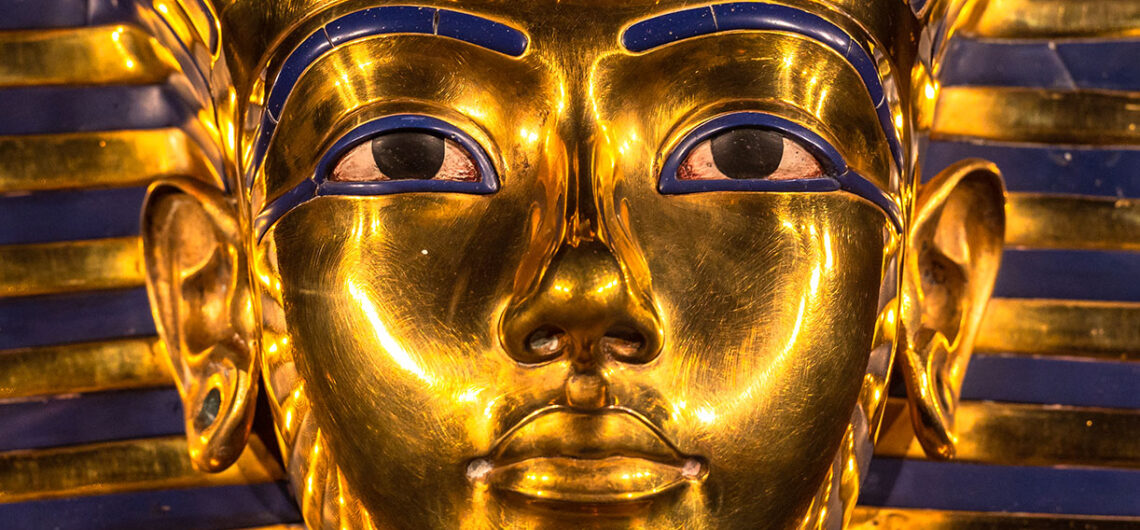King Tutankhamun– Discover new secrets and facts about W.’s lifeThe cause of King Tut’s sudden death How he lived, ate, drank, his life with his wife, and what studies were conducted on the mummy in Tomb of Tutankhamun in Valley of the Kings in Luxor, southern Egypt.
Discover Mummy Mystery, Mysteries of Tutankhamun Tomb, tut’s treasures hidden secrets, Facts, Information, Life Story, Death, Ankhesenamen, Mask, Funeral
Secrets & Mysteries of Tutankhamun: What we still don’t know?
- King Tut gave birth to two children, the first died at the age of 5 months and the second died in the mother’s womb Queen Ankhesenamun and he was buried the Mummy their own next to him in his tomb in the Valley of the Kings in Luxor, where each child’s mummy was buried in Pharaonic royal coffin of her own, the cause of death for two children was genetic diseases in the family Eighteenth Dynasty Pharaonic King Tut and the Queen were very saddened by the loss of the two children so quickly.
- King Tut lived with his wife in the royal palace in Memphis, He comes to Thebes in the south only to carry out royal ceremonies in religious ceremonies and Festivals in Ancient Egypt
- King Tut was depicted with scenes and drawings indicating that he was a brave and strong fighter, especially fighting enemies with arrows on top of the war chariot, symbolically to express to his people that he was a strong king and warrior who could control chaos, maintain order, and protect the country and borders from enemies.
- The young pharaoh was distinguished by intelligence and a high degree of intelligence Education Many writing instruments, tablets, pens made of reeds, cans for storing black and red ink, a water dish for cleaning the pen holder, and paper were discovered in his tomb Papyrus.
- The name of the Pharaoh King is not written in any of the lists Names of the Egyptian Pharaohs kings left by the ancient Egyptians.
- Scenes of inscriptions were discovered on walls Tomb of Maya in Saqqara, It belonged to one of the officials in the royal court, and he was the treasurer and the entire wealth of Egypt was managed by King Tut. King Tut was drawn at a young age sitting on the legs of his nanny as she played with him and took care of him in the royal palace.
- The first time it was discovered was in 1902 AD that there was a Pharaonic king named Tutankhamun, when more than 600 statues were discovered in a pit Karnak hideout “The Royal Cache of Deir el-Bahri” The big one in Karnak Temple Complex One of them bears the name of Little King Tut.
- He stumbled Egyptology on artifacts bearing the name of King Tut in various areas in the Valley of the Kings, with significant funding from the American businessman Theodore Davis, including the English archaeologist. Howard Carter study these discoveries and search for his royal tomb within Egyptian Tombs.
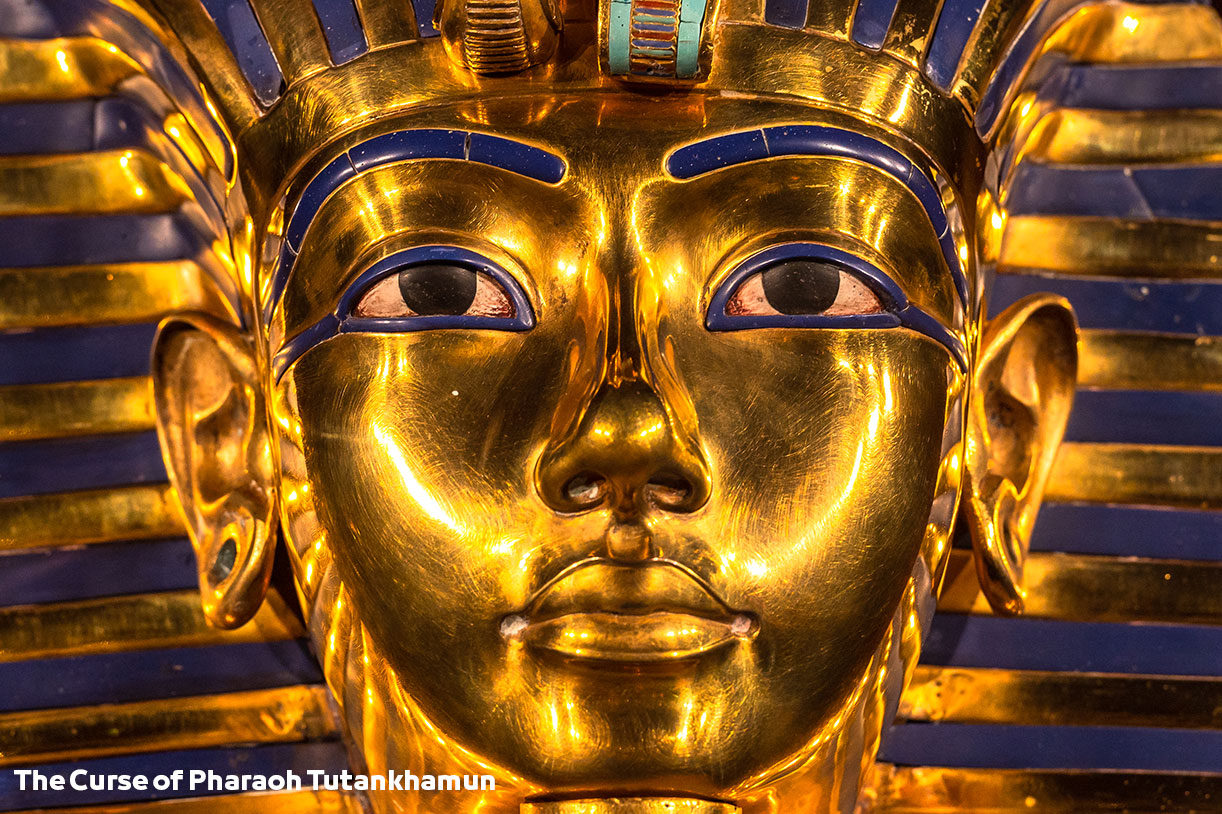
King Tutankhamun Facts and Information::
- He was born in the twelfth year of his rule King Akhenaton from his second wife Queen kiya, She died during the birth of Prince Tut and was named “Tutankhaten”, which means in Ancient Egyptian language ” The living image of the furnace.”
- King Akhenaten died 5 years after the birth of Prince Tutankhamun, and he had 6 daughters Queen Nefertiti, A famous person Female Pharaoh, Then he was the king Smenkhkare “The younger brother of King Akhenaten and married to his second daughter”, He is the legitimate heir to the throne of Egypt. His reign was short and he died, then King Tut took over the reins of power.
- King Tut took over the rule of Egypt at the age of 9 to 11 years, and the minister was running the country with him at the time king Ay, He was a special advisor to the young king and a senior official in the royal court. He was the brother of Queen Ti, “King Tut’s grandmother,” who assumed power immediately after the death of King Tut, and the military commander King Horemheb Who was then his guardian or co-ruler by virtue of the throne Ancient Egypt.
- After two or three years of assuming the reins of Egypt’s rule, the young king changed his name from “Tutankhaten” to “Tutankhamun” and restored The Egyptian Gods and religious beliefs in full, in addition to the return of priests God Amun After consulting his assistants in the government, the priest, that is, the army commander, Horemheb, who was Guardian On the throne In addition, many buildings were built in the temple of the god Amun in Karnak, such as Statue of God Khonsu, where it was discovered Sealed wine bottle, His tomb bears his name in the fourth year of his rule, telling us new facts about Ancient Egypt Facts during the reign of the young King Tut.
- He married his sister, Princess Ankhesenpaten, who is the third daughter of King Akhenaten from his beloved wife, Nefertiti. She changed her name after moving from Tell el-Amarna to Thebes to Ankhesenamun, as it was a tradition of kings Pharaohs Sisters intermarry. There are even kings who married their daughters, believing that this would preserve the bloodline Ownership and preventing marriage from outside the royal family to rule Egypt, as it was believed that girls were like deities and religious symbols. This was only done between kings and princesses and was not allowed to be applied Marriage traditions in ancient Egypt monarchy among the common people of ancient Egypt.
- King Tut is considered a grandson King Amenhotep III from the family series King Ahmose I chase Hyksos from The New Kingdom, Which is considered the golden age of ancient Egyptian civilization, as Tut was born during a period when Egypt was a strong empire, rich in gold and treasures, and lived in peace with its neighbors.
- King Tut did not have sons after him to take over the throne of Egypt, so here the priest roseany, The closest advisors to the king assumed the rule of the throne and became king on the throne of ancient Egypt. Immediately afterwards, the royal burial ceremonies for the young king began, where we find scenes of drawings on the walls of King Tut’s tomb by a priest Ay He performs burial rituals for the deceased king to give legitimacy to the heir to become the next king.
- Ruling period: 1332 – 1323 BC.
- Date of birth: 1341 BC.
- Place of birth: Tel Amarna area
- Burial place: Cemeterynumber62inValley of the Kings Luxor.
- Pharaonic Dynasty: Eighteenth Dynasty.
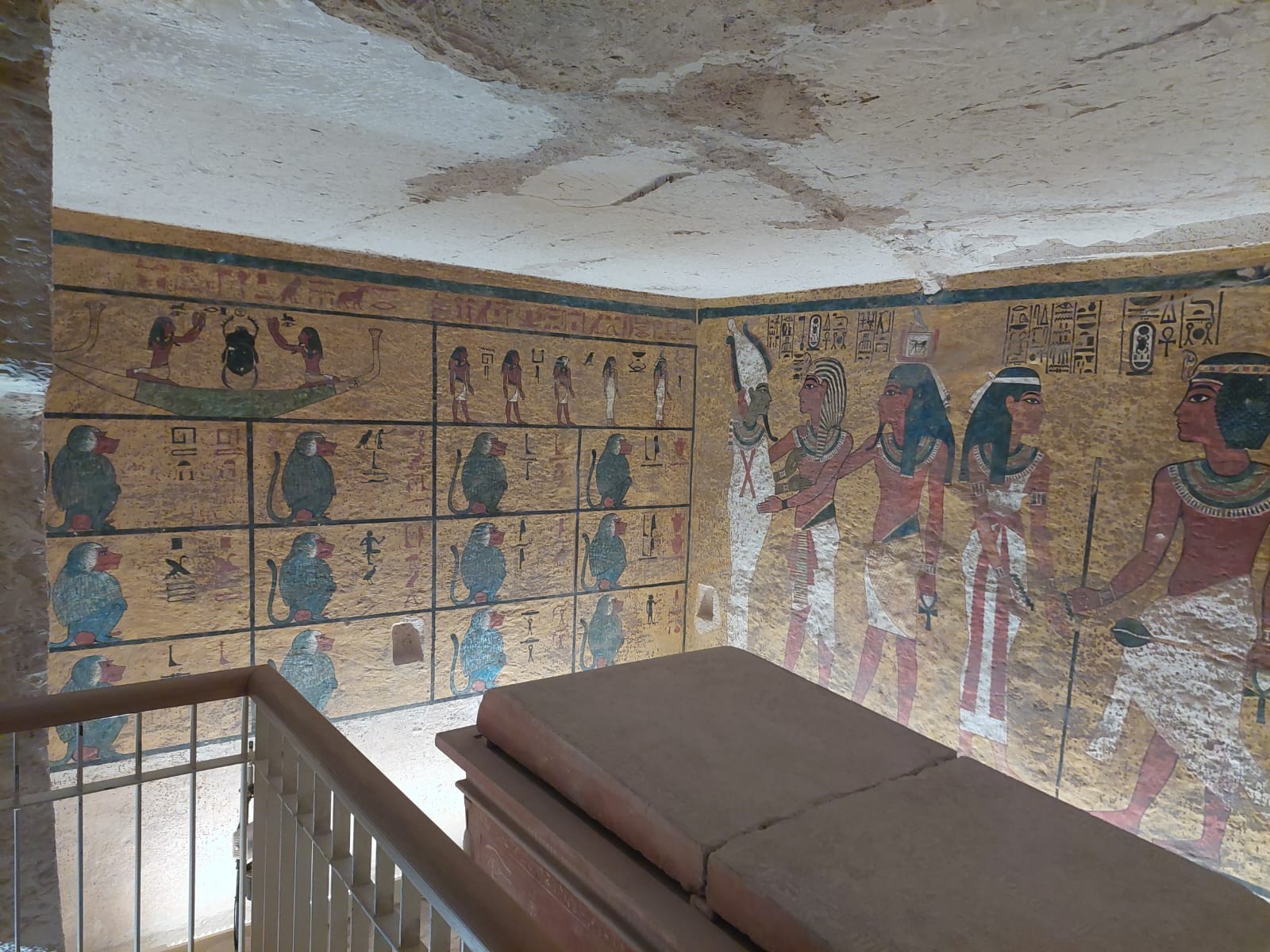
Tutankhamun Life Story – How did King Tut live?
The main residence of King Tut and his wife after he assumed power was in a palace in the city of Memphis in northern Egypt, made of mud bricks decorated with scenes of birds and plants on the walls and floors to show us the arts of Ancient Egyptian decoration.
King Tut used to come to the city of Thebes during the annual celebrations of the annual Valley Festival and live in Palace of Malkata, It belongs to King Amenhotep III, “the grandfather.” King Tut loved to go on fishing trips and boat rides with his wife in the lake that was located in front of Malqata Palace.
Scenes and drawings were discovered on the walls and floors of the palace that are similar to drawings of King Akhenaten’s palace in Amarna. King Tut’s palace has not been found in the city of Memphis yet.
King Tut loved the sport of hunting fish and birds with arrows. He was trained when he was young in hunting and war exercises to become a strong war leader in the city of Memphis in northern Egypt, where drawings of King Tut were discovered on stone blocks with his trainer teaching him how to hunt, in addition to drawings of him practicing sports. Wrestling, stick fighting and other martial arts.
What food did Tutankhamun Eat & Drinks?
King Tut loved to eat chickpeas, lentils, garlic, onions, and peas in all of his daily meals, in addition to his great love for eating sheep and goat meat, in addition to eating ducks, geese, and bull meat, which was included in the list Pharaonic royal Ancient Egyptian Food.
King Tut loved to play a lot The Games of the Pharaohs, The ancient Egyptian game with his wife and friends in the royal palace, such as the “backgammon game” and the “cent” game, which is an Egyptian Pharaonic game consisting of 30 squares. Each player had 7 pieces that were moved and used the stick to throw them on the table to move his pieces according to the direction of the edge of the stick, in addition to the “twenty squares” game. “Which is similar to the modern Ludo game today, where each player has 5 pieces to move.
King Tut preferred to drink wine and fruit juice and did not prefer drinking beer, in addition to eating a lot of sweets and sugars in his daily meals, such as honey, figs, raisins, and seasonal dates.
The little king’s breakfast was bread and cakes, and the king also liked to add more spices to his food, such as black cumin, fenugreek, coriander, and sesame.
Love Story Tutankhamun’s Wife Ankhesenamen:
It was discovered that there was an intense love affair between King Tut and he would tell us what it was like Love in Ancient Egypt, These emotional feelings between the spouses were embodied on all the walls of the Pharaonic tombs and the royal furniture, especially…
- The scene of the golden throne describes the state of the queen as she helps her husband and carries a bowl of aromatic oils to anoint his shoulders and legs.
- Views of the royal cabin of King Tut on his hunting trips to Thebes to hunt ducks and geese, and she gives him arrows to hunt ducks.
- A scene depicting the king sitting on the throne pouring water on his wife as she sat at his feet.
- A scene depicting the queen tying a necklace around King Tut’s neck and many daily life matters as they sat on the throne of ancient Egypt.
- None have been discovered yetStatue of the queen Ankhesenmun, all of whom were discovered drawings of scenes with her husband, King Tut, on royal furniture.
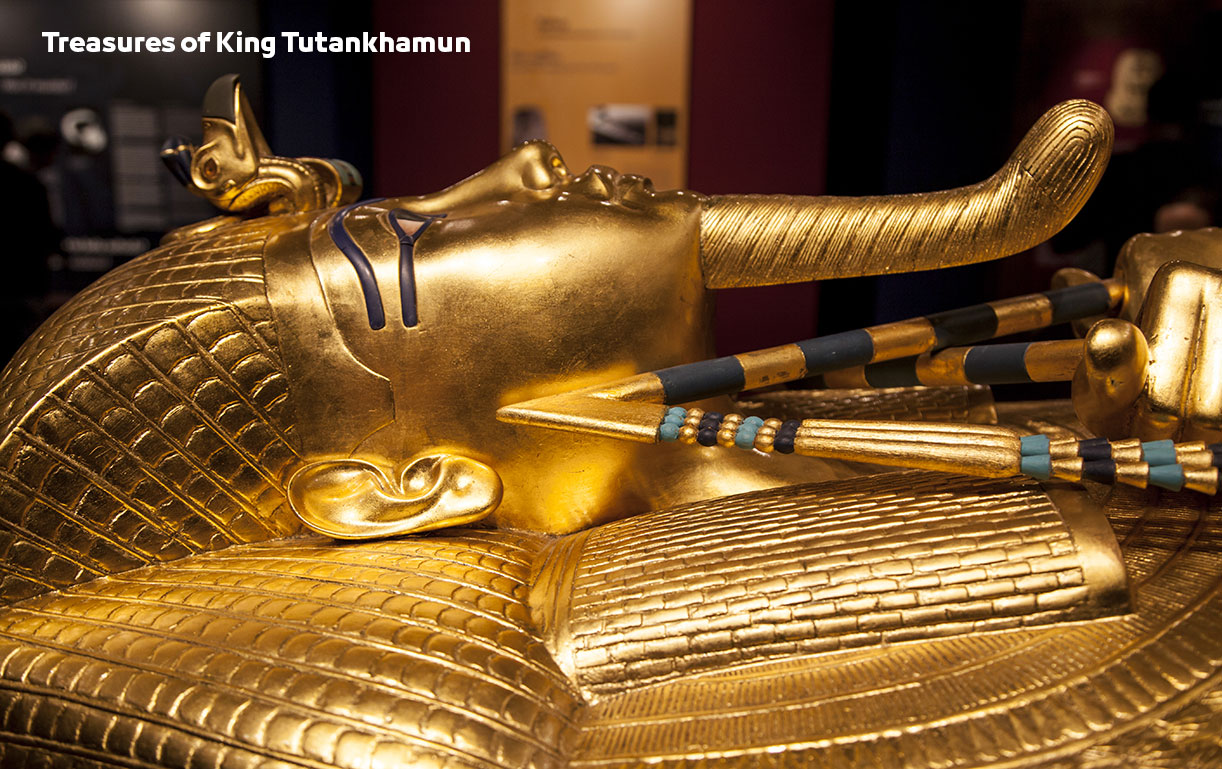
Treasures of King Tutankhamun:
- More than 5,398 artifacts were found in his tomb, which turned out to be not built for him, but rather The Tomb of King Ayi.
- A gold mask weighing 12 kg.
- King Tut wore a royal necklace around his neck, known in the Egyptian language Hieroglyphs with a dirtier name, it was removed by an English archaeologistHoward CarterSo that he can remove the golden mask.
- A golden crown studded with gold, a snake and a cobra to protect the little king with his life in the other world.
- 104 gold pieces inside the mummy and around it in the first coffin, such as 6 royal contracts with a falcon head that were inside the dilapidated rib cage.
- Dagger made of Gold he was buried with the king’s body, in order to use it in the afterlife to defend himself.
- The boy king’s mummy and treasures were buried more than 3,000 years BC.
- Sundoo has been discovered QA small one containing King Tut’s scepter and flail, which he used during coronation celebrations to the throne of Egypt.
- A golden fan was discovered depicting scenes of King Tut on a war chariot during a trip to hunt ostriches while he was shooting arrows at them. A view on the other side of the fan shows the young king returning to his royal palace with ostriches, where royal fans were made from ostrich feathers.
- A royal box was discovered depicting King Tut hunting lions and another scene of him fighting enemies on his royal war chariot, victorious over them.
- Inside the tomb, 130 sticks were discovered that King Tut used to help him walk and stand, as he was suffering from a disease in his legs.
- King Tut was drawn hunting animals in Wadi al-Ghazal near the Sphinx area of the city of Memphis while he was sitting and not standing, which indicates that he was afflicted with a disease in his legs that prevented him from standing easily on his feet.
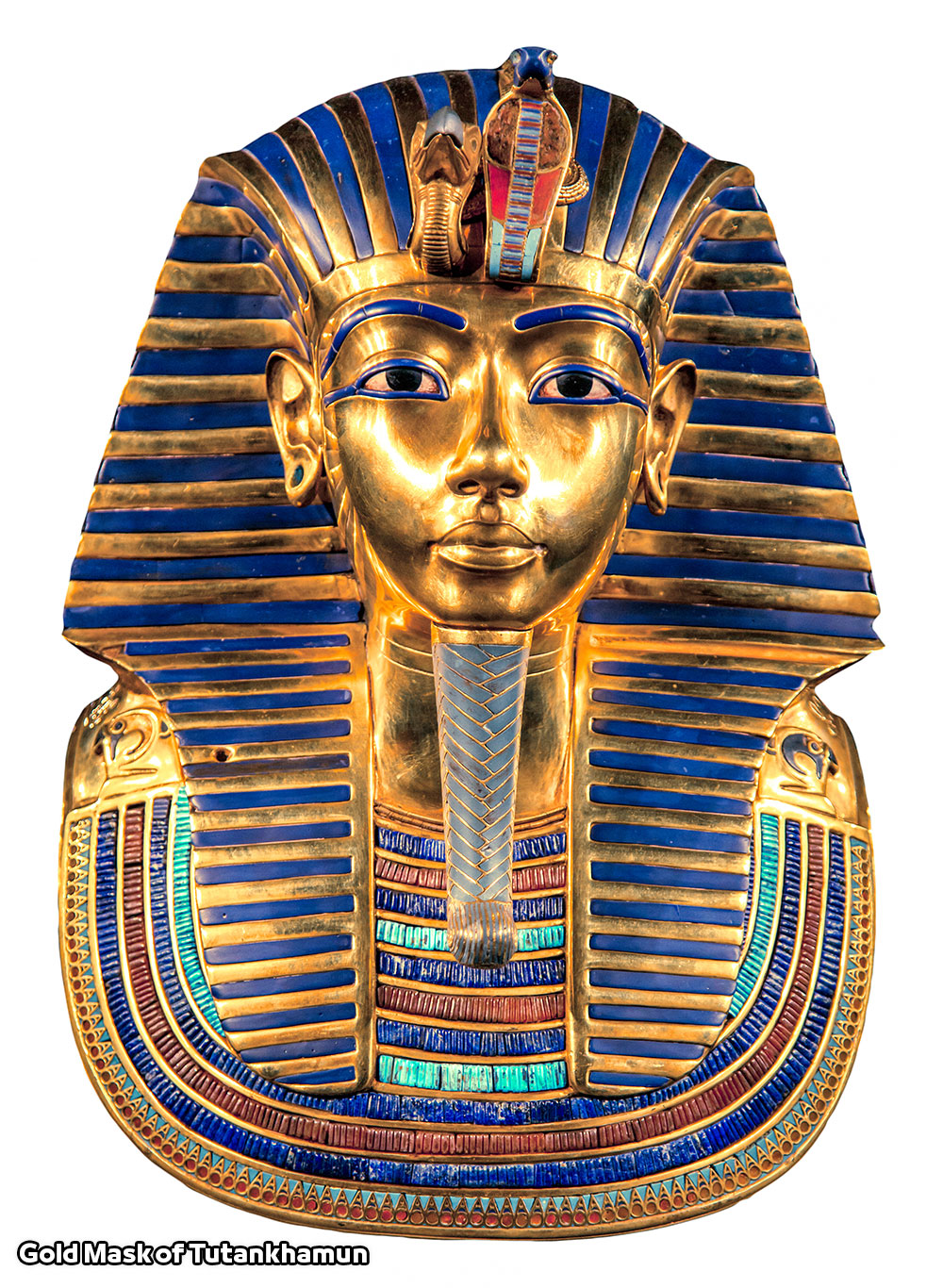
Description of The Gold Mask of Tutankhamun:
- The face is made of pure gold, the eyebrow is made of lapis lazuli, and the eyes are made of white quartz and black obsidian.
- The headdress ribbons were made of gold and blue glass, and the royal beard was made of gold and lapis lazuli.
- A special gold cobra “symbol of Lower Egypt” and an eagle “symbol of Upper Egypt” were added to the front of the mask.
- There is a “Al-Awsikh” necklace around the neck covering the king’s chest.
- Behind the mask there are inscriptions and writings with magical texts to protect the king during his journey in the afterlife. They are texts for God Anubis “Symbol of cowardice” and God Ra “Symbol of the sun” and God Horus I swear God Ptah God Sokar “Symbol of the Dead” and a group of deities Religious life in ancient Egypt.
- Mask Weight: 25 lbs.
- Length: 2 feet.
- The front of the mask is made of fine gold.
- It consists of a base of pure gold inlaid with rare stones such as obsidian, quartz and very rare and precious lapis lazuli..

Description of Tutankhamun’s coffin:
King Tut’s mummy was placed inside 3 coffins on top of each other. The first inner coffin was placed in it and was made of solid gold. Then the coffin was placed inside a coffin made of wood and covered with gold and precious stones, then the third coffin was made of wood and plated with gold.
The third coffin was covered with a roll of linen, then the stone lid of the main fixed coffin was placed in the burial chamber in the shape of a rectangle, then 4 painted compartments covered with gold were added around the stone coffin.
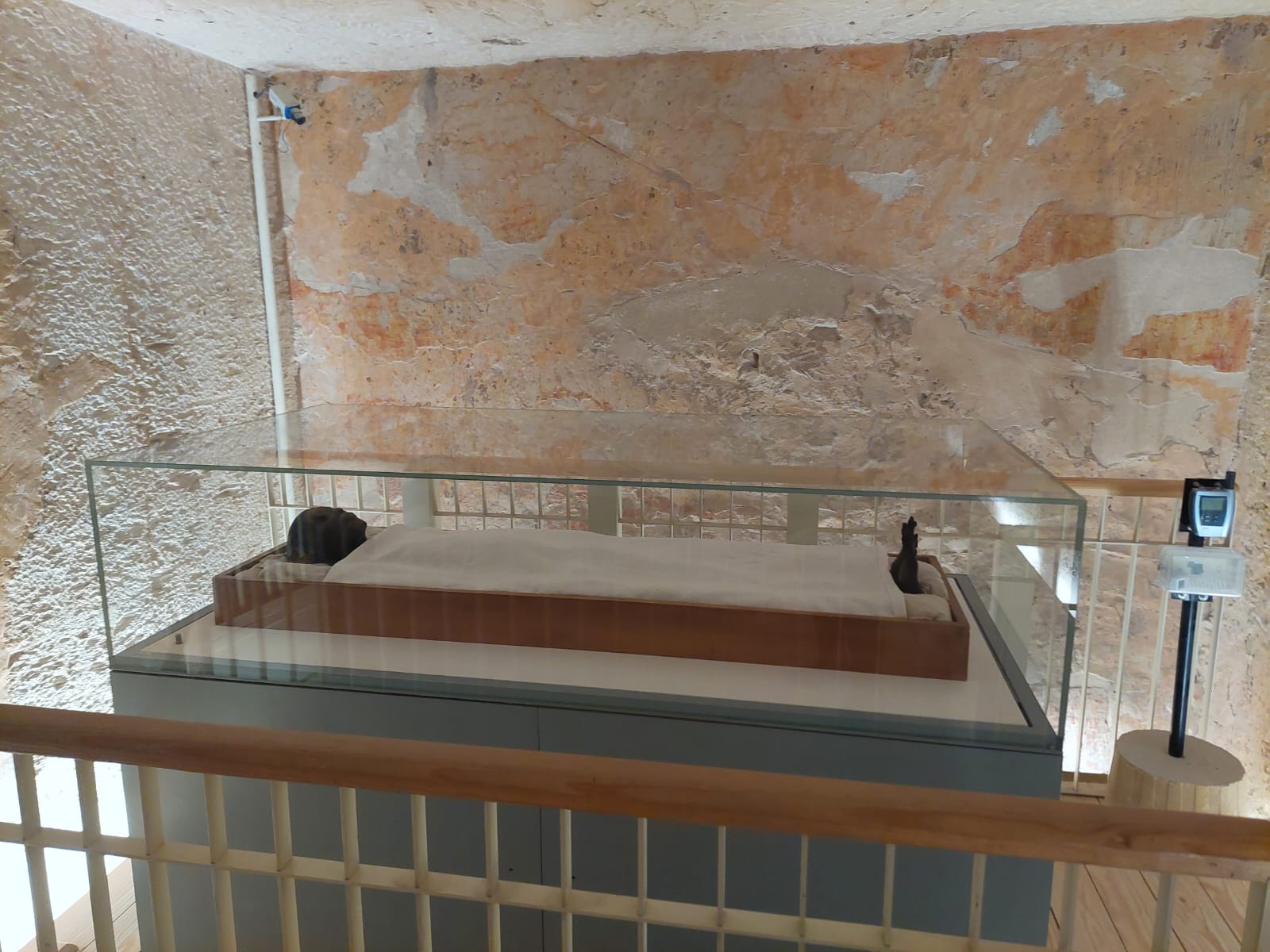
Royal coronation celebration:
The coronation of the young king was celebrated, with him sitting on the throne of Egypt and presenting the five royal crowns, which are…
The white crown: means that he is the king of Upper Egypt and even southern Egypt Nubia.
The red crown: means that he is the king of Egypt in the north.
The double crown: means that he ruled Egypt in both the north and the south.
Blue crown: means he is a leader Egyptian army, He has the ability to lead wars and battles against enemies.
Nams head cover: It is a piece of cloth that hangs over the shoulders and then a crown is added on top of it.
King Tutankhamun’s crown always contained a cobra, a symbol of the God Wadjet, The protector of Egypt, northern Egypt, and the female osprey, a symbol of the God Nekhbet, The garrison of southern Egypt.
During celebrations, King Tut always held the scepter as an expression of his care for his people, and the flail in the other hand to indicate that he was a strong and brave king.
Each Pharaonic king had 5 titles. King Tut received the title “Tutankhaten” upon his birth, then the title “Nebhebru Ra” when he became king and ruler of the throne of ancient Egypt. These titles were written on a letterhead Pharaonic Cartridges Property, or tomb walls, statues and Funerary Equipment the royal buried with him.
The outbreak of the Hittite War:
There have been treaties and alliances for more than 50 years with Kingdom of Mitanni, Which is located north of the Euphrates River (now Syria), where political and social relations between the two countries were strengthened by the marriage of the princesses of the Kingdom of Mitanni to King Amenhotep III and King Thutmose IV, May peace and prosperity prevail.
After the death of King Akhenaten, wars broke out between the empires Hittites“A region in present-day Turkey” and the armies of the Kingdom of Mitanni. Then the Hittite armies began to head to the borders of Egypt to begin a strong war against this invasion.
What did king Tutankhamun accomplish during his reign?
Once the young king took over the rule of the country bLand of the Nile Valley”Black Earth“And the desert in the west and the east “Red countryHe did a number of jobs, including…
- Re-trade with Syria and Njao country, It is known to contain trees Oak, pine, cedar and juniper, Which was used in industry Holy boats Indigo, which are the boats of the god Amun, to be used in celebration ceremonies holiday Opet, one of the most important ancient Pharaonic holidays that stopped for more than 20 years, and discover what it was like Trade in Ancient Egypt.
- Sharing official holidays and celebrations with his people.
- The importance of worshiping the god AmunMachineThe city of Thebes and the god PtahMachineCity of Memphis.
- Reopening all small and large temples for all gods, deities and religious beliefs in all regions of Egypt and providing financial funding, slaves, servants and priests to serve the temple..
- Rebuilding the boats and ships of the godsto be usedIn annual celebrations.
- Bring back the name of the god Amun Luxor temple after his father, King Akhenaten, rose By removing it, He was interested in restoring buildings and temples and decorating the walls of the mayoral hall with Pharaonic scenes and inscriptions to draw closer to the Egyptian gods, especially the Theban trinity..
- Building huge statues of quartzite stone and placing them in the Karnak Temple, its cemetery, and its funerary temple, which was usurped by the king, that is, then King Horemheb seized it and attributed it to him.
Feast of the Pharaonic Opet:
Amun compound is manufacturedAt its front and back are two ram heads and the compound of God Mut Two-headed lady wearing the head of an eagleAnd a compoundWith two falcon headsAnd large boats for the king, queen, and courtiers.
The Nile cruise begins with a huge presence of ancient Egyptians on either side The Nile River, And they singSong of AmunAnd the bells are ringingFor drumsTo begin the boat journey from Luxor Temple to Karnak Temple through a road paved on both sides with statues in the shape of rams, and the journey ends in their cabins.
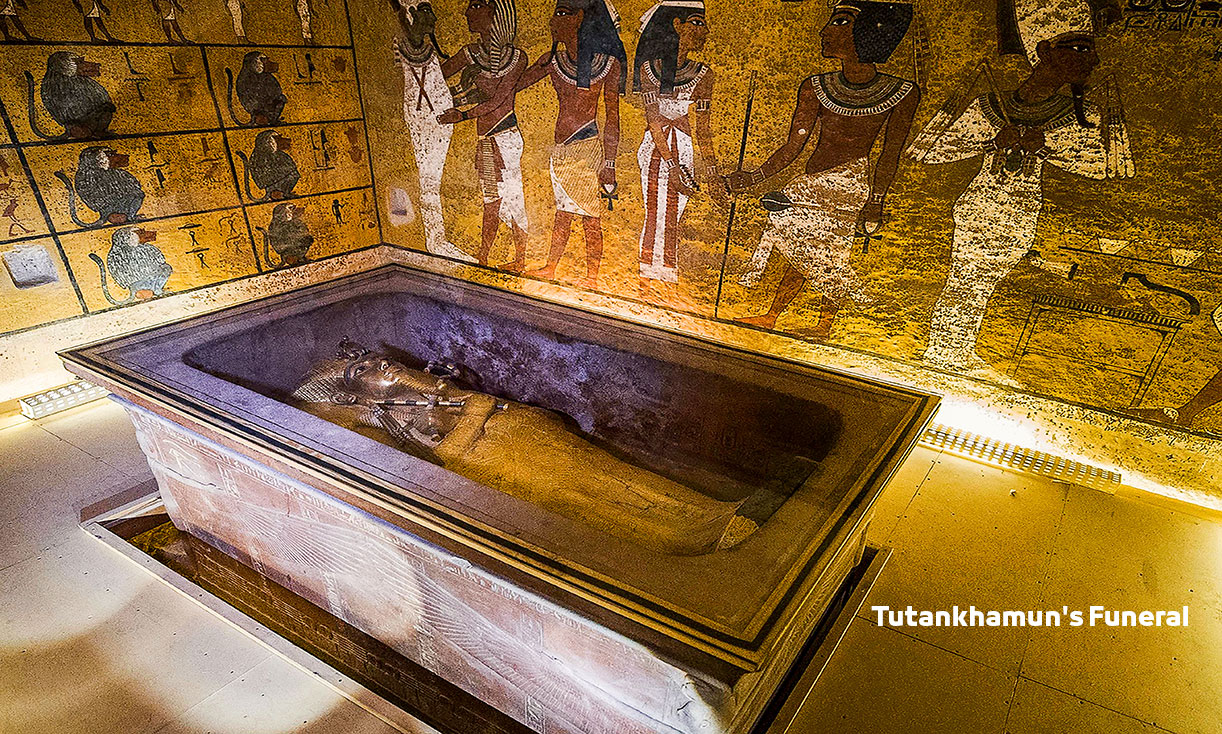
Tutankhamun’s Funeral:
- King Tut began building his tomb shortly after assuming the throne of Egypt. When the king died suddenly, the tomb was not complete, so he was buried in a new, small-sized tomb. It was supervised by the royal treasurer, “Maya,” who was the supervisor of all royal buildings during the era of King Tut, where he drew the inscriptions and drawings. The burial chamber in only 70 days.
- King Tut’s body was transferred to the royal mummification headquarters, “Bar Nefer, or the Beautiful House”. The royal mummification process is carried out by cutting the left side of the abdomen to remove the liver, intestines, stomach and lungs from the rib cage. Then they are dried separately, then each piece is wrapped in linen wraps, then each piece is placed inside a container. It is small and then placed inside an alabaster box divided into 4 sections. Each section has a cover in the shape of king Tutankhamun face wearing a mongoose cover.
- The brain was removed from the skull by pulling it from its nostril, then the king’s body was placed on a bed containing natron salt to dry the body and preserve it for long periods of 40 days until it dries completely and turns into a mummy. Then the linen wraps were wrapped, then the royal jewelry and amulets were added to the mummy, then it was re-wrapped. The body was wrapped in linen, and finally, the golden king’s mask was placed on the face to cover the head and shoulders of king Tutankhamun.
- The ceremony has been completed The Mummification of the Pharaohs Royal adding resin to the king’s entire body to preserve it and starting the prayer steps of the priests of Amun, then placing the mummy in the golden coffin and starting the royal funeral through a royal cabin “decorated with flowers and a wreath and a cobra drawn on the ceiling of the cabin to protect king Tutankhamun” on a wooden sled pulled by 12 members of the priests. The officials at the Royal Palace then go directly to the cemetery in the Valley of the Kings.
- The king appeared to wear the clothes of priests “in the shape of a leopard’s skin” to perform the ancient Egyptian ritual of burying the dead, the “opening the mouth ritual.” He began by placing the mummy in an upright position, then began using ritual tools by touching the eyes, nose, and mouth to express that he was giving a king how to see, breathe, and eat in the afterlife.
- Then began the stage of eating royal food outside the cemetery in a tent for the royal family to share with the deceased, and then the rest of the food was buried with the mummy in clay pots.
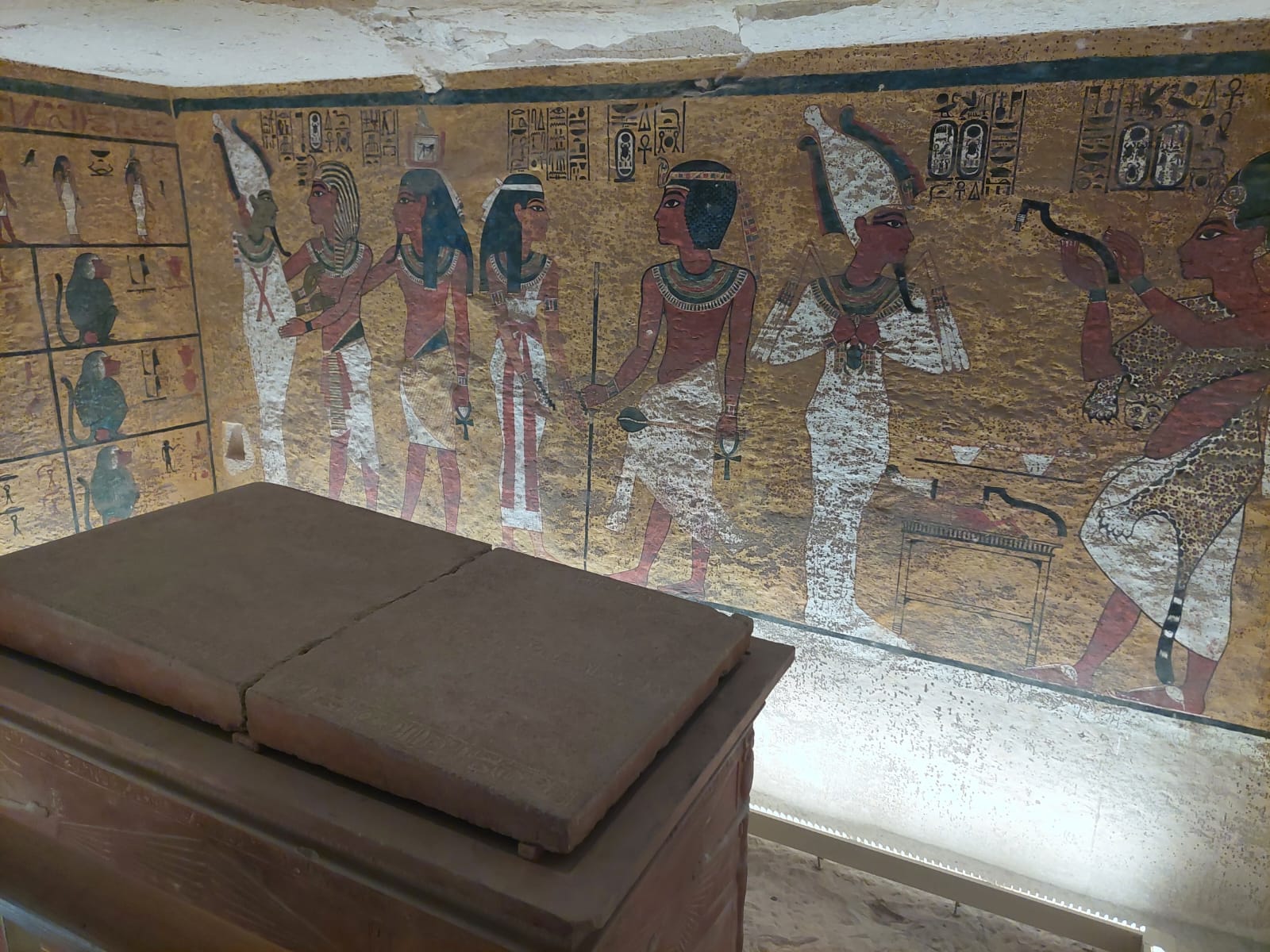
What happened after the death of King Tutankhamun?
Queen Ankhesenamun feared for the rule of the throne of Egypt, as she did not have children from King Tut. Therefore, there is no legitimate heir to rule the country and she does not have a brother of royal blood to marry to share the throne of Egypt with her.
Queen Ankhesen Amun sent a message to the Hittite king, saying to him, “They say that you have many sons, so give me one of them, and he will be my husband, and he will be the king of Egypt.”
No one knows why the Pharaonic queen did this, as Egyptian queens and princesses were forbidden from marrying foreigners. Perhaps the reason was because she did not want to marry Horemheb, or because she believed that they had participated in the murder of her husband, King Tut, or because she was afraid of the Hittites occupying Egypt after the news spread. The victory of the Hittite army over the Egyptian army on the border.
Indeed, the Hittite king initially sent a messenger to check on the queen, and then he sent one of his sons. On the way, he was killed. It is believed that he was killed by order of the leader, Horemheb, or after they learned of the content of the message.
The Hittite king was angry after learning of his son’s death and sent a huge army to attack Egypt. After his victory in the battle, he captured many soldiers and put them in prisons in his country. These soldiers were carrying the black plague disease, and it spread quickly, causing the death of many soldiers in the Hittite army.
Queen Ankhesenamun married Ay and became king to rule ancient Egypt. Many artifacts were discovered indicating their marriage, such as a ring made of porcelain bearing the names of the two kings, which is now displayed in Berlin Museum Germany, a statue of King Ay and Queen Ankhesenamun together.
The king ruled the throne of Egypt for 4 years, and he was old. He had a young son named Prince Nakht Min.
After the death of the king Ay, Commander Horemheb seized the throne of ancient Egypt to become the king of the country. He destroyed the statues of Prince Nakhtemen, removed the names of King Akhenaten from the royal records, and disposed of their antiquities and buildings in the regions of Egypt. He hated King Akhenaten when he unified the worship of the gods into a cult. There is one God and He is God Aton Sun symbol.
King Horemheb removed the name of King Tut from the records of the names of the Pharaonic kings, as the name of King Tut and the kings that ruled Egypt were forgotten, and his name was not mentioned, and his royal tomb remained hidden for more than 200 years. Ancient Egyptian Grave Robbers until workers came Tomb of Ramses VI, They built their own huts on it and it remained hidden until it was discovered 3000 years later by the English archaeologist Carter.
Autopsy Unmasks King Tut’s True Face:
Here were 3 suggestions for the shape of King Tut’s face before he died, by making plastic models, then adding clay, then making another model of the face with silicone, then the technician begins adding eyes and hair and adding artistic touches to the anatomy of the face.
The suggestions were from Egypt, America, and France, and all the suggestions were almost identical, reaching 65% of the true form and composition of king Tutankhamun.
Tut’s Treasures Hidden Secrets

Prudhoe Lions
It is a statue made ofRed graniteShowing now in The British Museum, England, he was once present as a guard, He guards The Temple of Soleb in Nubia, belonging to his grandfather, King Amenhotep III, texts and writings were discovered in the ancient Egyptian language that mean “king Tutankhamun, who renewed the relics of his father, NebMaatretre Amenhotep, all of which were NebMaatretre Amenhotep, the ruler of Thebes.”.
Statue Karnak Hideout
A statue was discovered with in Karnak hideout and a statue The god Khonsu A comparison was made between them, and it was found that they belonged to King Tut when he was twenty years old, as the features of the body were thin, the mouth was thick, and the eyes were drawn.
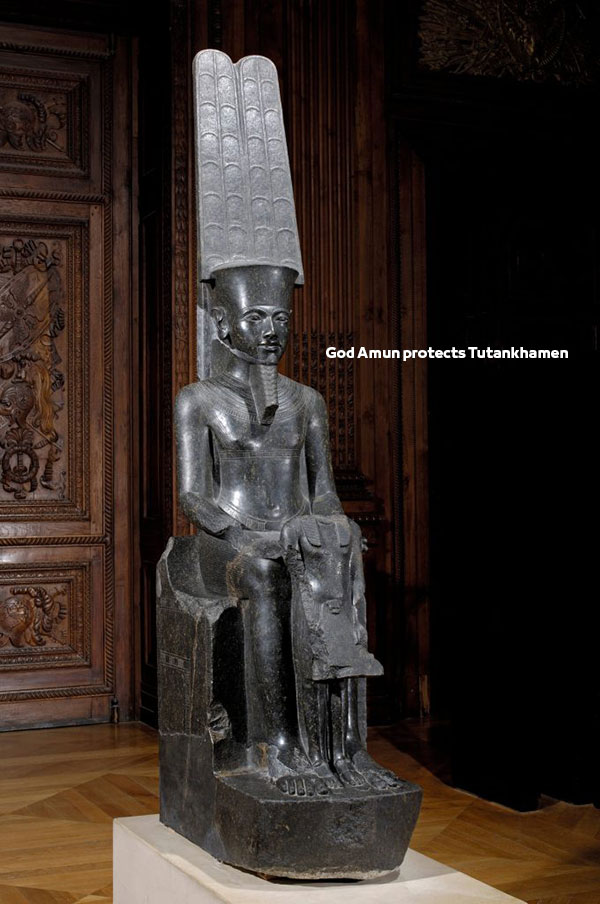
Statue Amon protecting king Tutankhamun
A statue made of dark diorite stone is displayed in Louvre Museum, It belonged to the little king and was built in the Glorious EraTo GodAmun and the restoration of the worship of the Egyptian gods and religious beliefsOld,It was discovered in the Karnak Temple Complex in 1857 AD and was transported to France.
Description of the statue:
Height=78 cm, Height=220 cm, Width = 44 cm
The figure of king Tutankhamun standing before the god Amun, sitting on a cubic-shaped seat, was carved in a figure man kind, The little king wears the cat skin of the priests.
Because of the hostility, King Tut’s head was smashed, and his beard, part of the pleated apron, and the hands of the god Amun were broken.
Inscriptions and views of the tomb of Amenhotep “Havi”
Scenes and drawings were discovered on walls Tomb of Amenhotep in Saqqara “Hawi”SundayImportant employees in The government in the ancient Egyptian, During the reign of Tut” NoTT40 with graves Kind, The small Pharaonic king appears by directing the appointment of the chief priests of Amun and officials By repeating Opening temples and shrines To God Ancient Egyptian culture returned to what it was 20 years ago after it completely stopped By orders Ownership of King Akhenaten Sr.
Stone panel of white limestone
Now on display in the Berlin MuseumIn Germany, Scenes depicting king Tutankhamun A furnace Offers offerings To God Amun Ra and the god Mut in Kind,Which indicates that King Tut kept his original name while he was in the city of Thebes By repeating Worshiper of the Theban trinity And the rest Ancient Egyptian gods.
king Tutankhamun funerary temple:
King Tut was interested in creating Mortuary Templeson Left bank of the Nile Towards sunrise next to Mortuary Temple of Amenhotep III on advice from the Minister Amenhotep, son of Hapu and The foundations of the temple had already been built for the young king, but it was not completed, and after his death, the king usurped it King Horemheb And attributed to him.
The remains of buildings of a small temple and Two quartzite statues While on mission Oriental Institute in Chicago, it was found that it belonged to King Tut after a careful examination of the inscriptions and texts written on stones and archaeological statues.
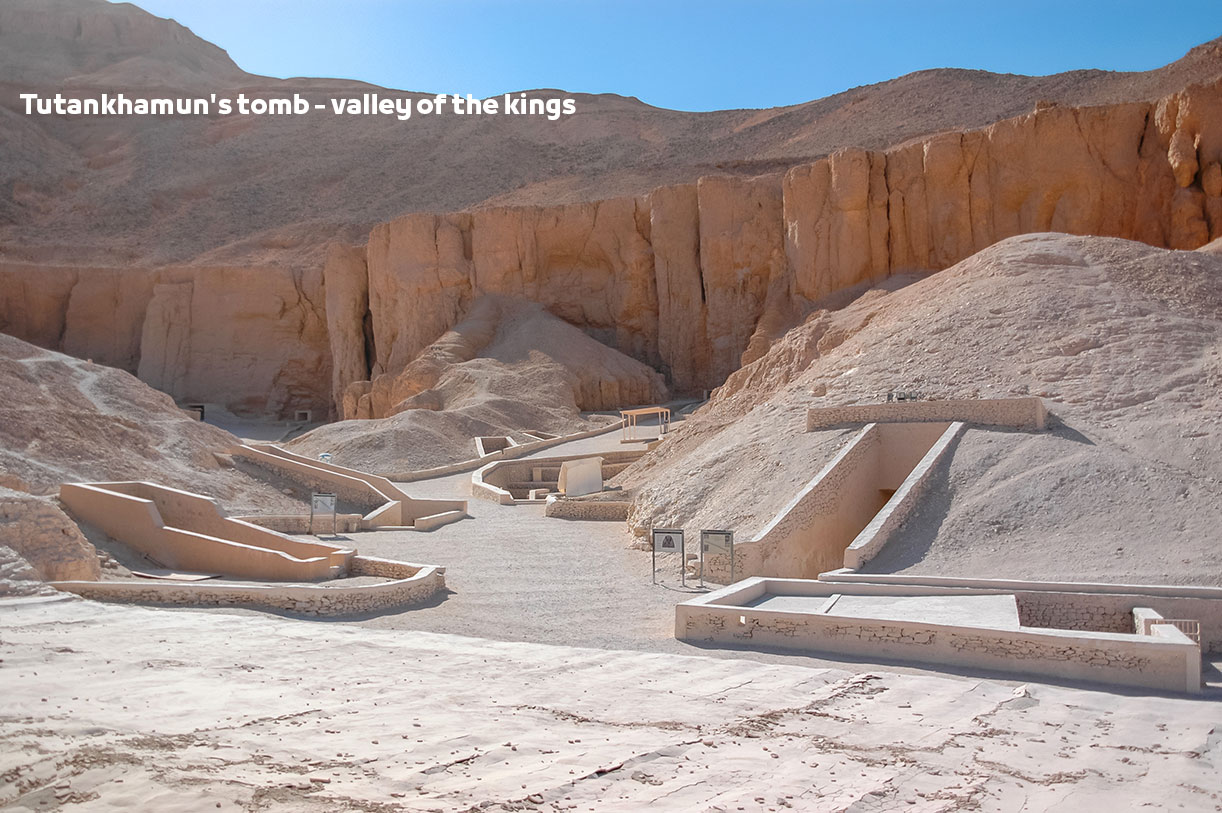
Tutankhamun’s tomb
A quick royal cemetery was established to bury the mummy of king Tutankhamun in the tombs of the Pharaohs’ kings of the Eighteenth Pharaonic Dynasty in the Valley of the Kings in Luxor, where the sudden death of the young king made the burial ceremony take place quickly, in addition to placing the funerary furniture, jewelry, and supplies of the king for his afterlife in a random manner inside a small room.

Facts about the Discovery of King Tut’s Tomb:
- The body of king Tutankhamun was drawn on the walls of the tomb, with a slight sag in the abdominal area and wide buttocks, despite the fact that the young king’s body was pear-shaped, with a narrow waist, and his height was 160 cm, “as the artists of Amarna were interested in drawing kings in this way, as in the case of the king Akhenaten.”
- The cemetery was discovered in the early hours of the morning of November 1, 1922 AD by a boy from the Egyptian labor team, “a member of the famous Abdul Rasoul family,” 3 weeks after his return.Howard CarterFrom England to obtain funding from Lord Carnevon.
- There were wreaths of rare flowers from the Pharaonic era, but they collapsed as soon as an attempt was made to move them outside the tomb at that time..
- All Pharaonic belongings and treasures found in the tomb were recorded for a full year.
- There were attempts to rob Tut’s tomb, but they were unsuccessful.
- A group of royal seals was discovered at the entrance to the royal cemetery.
- Howard Carter discovered a complete Pharaonic list of the contents of the treasures. Upon examining all the tools in the two rooms, it turned out that a group of treasures had been stolen..
- The tomb was opened and closed during the era of King Horemheb.
- A fan of ostrich feathers was discovered inside king Tutankhamun burial stone.
- King Tut’s mummy was buried without the heart. There is an explanation that the reason is the negligence of the royal mummification supervisors or the king’s mummification process was carried out far from the burial place, which helped the heart to deteriorate quickly.
- Musical instruments were discovered for the king to use in religious rituals during his life after death.
- Two iron daggers and the other with a pure gold blade were discovered in the mummy of king Tutankhamun..
- It took Howard Carter 8 years of work to transfer all the contents of the tomb due to the small size of the tomb and the techniques that were used in ancient times to record and photograph all of King Tut’s treasures and delivered to Egyptian Ministry of Tourism and Antiquities.

How many pieces were found in Tutankhamun’s Tomb?
Have been foundMore than 5000An artifact belonging to King Tutankhamun, to be with him and serve him in his afterlife after death.
What was discovered in Tutankhamun’s tomb:
- King Tut’s clothes.
- a group of Pharaonic Ushabti Statues and Pharaonic Scarab.
- Small golden statues made of rare stones.
- King’s furniture pieces.
- King chairs.
- Gold accessories and jewelry.
- A large collection of Pharaonic scarabs.
- Fabrics.
- incense.
- Ornamental materials for the king.
- Pottery vessels.
- Lamps for lighting.
- Little king games.
- Gold bowls.
- Military equipment.
- Military chariots.
Where are King Tut’s belongings now?
All discovered belongings were completely transferred to The Grand Egyptian Museum in Cairo.
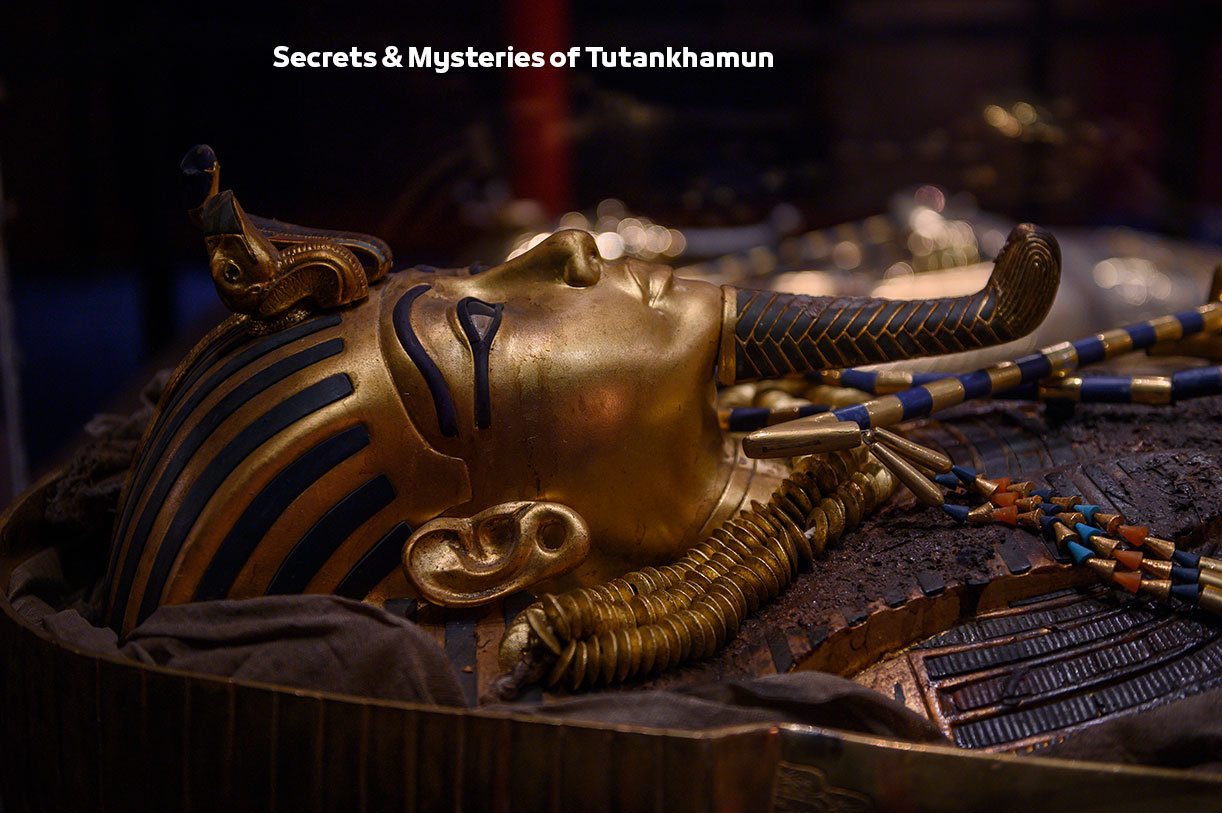
The cause of King Tut’s sudden death? How did Tutankhamun die?
King Tut died suddenly while army commander Horemheb headed north to fight the Hittite army.
Numerous CT scans and X-rays were performed on King Tut’s body. No signs of wounds or disease were discovered, indicating that he died due to a war wound or a hereditary disease.
American archaeologist Bob Brier discovered that the cause of King Tut’s death was due to a blow to the back of the head from someone who tried to kill him, but King Tut did not die at the time and was not treated quickly medically, but it was a wrong theory.
Stages of Studying King Tutankhamun’s Mummy:
Many studies have been carried out and comprehensive CT scans have been performed Advanced CT-Scan to determine the cause of King Tut’s sudden death at a young age. Was it due to hereditary diseases, or was it due to an organic disease, or was it due to betrayal and his murder, or was his death natural?
Many people in the Egyptian government, members of the Egyptian House of Representatives, and many people of the city of Luxor objected to the transfer of King Tut’s mummy from his tomb in the Valley of the Kings to the professional and advanced X-ray laboratories in Cairo. Therefore, when king Tutankhamun mummy is studied, it is only studied while it is inside the tomb, whether a team An Egyptian research team, a foreign team, or a mixed team of Egyptologists, researchers, and professional archaeologists only.
The first stage – 1925
The first study began on November 11, 1925 AD, with a team consisting of an English archaeologistHoward CarterDr. Deir, who specializes in studying the science of Pharaonic mummies, and Dr. Saleh Bey Hamdi, “University Alexandria“.
The research team re-studied the mummy inside a corridor Tomb of King Seti II, He was inside his first coffin to prevent fungi from interacting with the outside air quickly. It was discovered that the linen wraps around the king’s body were covered with paraffin wax and were in a state of rapid decomposition because the inner wrappings covering the king’s body were small, frayed, and quickly interacted with the air.
The English archaeologist did notHoward Carter, He published some details of the anatomy of King Tut’s mummy through scientific platforms, where he Dr. Harrison and his research team are in the process of completely separating the head from the body, then removing the pelvic bone from the torso and removing the legs, arms and lower feet from each other to be studied with X-rays.
After completing the study in 1926 AD, the mummy had to be completely returned to the first coffin in the royal cemetery. The mummy was naked without linen wraps and was covered with sand, in addition to reattaching the legs to the ankles and the arms to the anchor using resin, then adding the second stone coffin, then installing a box. Q Glass was placed around the coffin to protect it from interaction with fungi and dust in the air that enters the tomb after it is opened.
Facts when studying the king Tutankhamun Mummy for the first time:
- During the royal embalming ceremony, the ancient Egyptian embalmers made a fatal mistake, which was adding oils and resin directly to the skin and body of King Tut, then wrapping the body in linen, then placing the mummy exposed to the hot rays of the sun, which caused the golden mask to stick to the head and the entire body to stick to the first coffin.
- Dery cut the linen rolls with a knife as the first researcher to study King Tut’s mummy in the presence of the research team.
- Hot knives were used so that the research team could remove the golden mask of King Tut that was tightly attached to the face, cut the linen wraps around the body of the Pharaonic king, and remove the mummy from the royal coffin.
- The mummy of King Tut was found for the first time covered with a golden cover, tied to his head, and around his neck was a group of royal necklaces.
- The ancient embalmers added more than 110 pharaonic pieces belonging to the king inside the mummy and covered the fingers and feet with an external cover, in addition to royal golden sandals on the feet.
- When the linen rolls were cut from the body, King Tut’s penis was fully erect.
- Injuries were discovered at the navel area and injuries up to the bone of the left leg joint as a result of the rapid mummification of the young king’s body.
- The position of King Tut’s body inside the coffin was the left arm above the right arm, bent at the elbow and crossed at the waist. The head was without hair and covered with a thick white cover with a layer of beads and the cartridges of the Pharaonic funerary furnace on top.
Discoveries:
- Dery said that King Tut died at the age of between 18 and 22 years.
- The shape of king Tutankhamun skull is similar in anatomical structure to the shapes of skulls found in Tomb KV55 in the Valley of the Kings.
The Second Stage – 1968:
Dr. Harrison, Professor of Anatomy at the University of Liverpool, England, studied the mummy again using X-rays while a group of tourist visitors were present. The following was discovered:
- There was a major mistake made by Carter’s team while reburying the mummy in the coffin after studying it without professionalism and scientific methods, as king Tutankhamun body was dismantled into pieces inside the coffin in a bad way.
- The king’s skull was completely empty inside, and accumulations of fossilized resin and a small bone were discovered inside.
- Harrison’s suggestion that King Tut was killed by treason on the back of the head.
- It was discovered that the rib cage was missing from the mummy.
Other theories about King Tut’s death:
- There was a theory from Dr. Nicholas Reeves that during the rapid royal mummification of King Tut, the entrails were removed and replaced with pieces of cloth, in addition to the rib cage, and that the head injury was a result of the error of the ancient Egyptian embalmers.
- Forbes suggested that King Tut had a head injury as a result of a chariot accident during the battle. The accident caused a fracture in the rib cage and the left jaw of the skull, and he was treated quickly so that the wound could heal while King Tut was dying and before his death.
- Voris discovered the disappearance of King Tut’s erect penis, as there were pictures approved and documented by Dr. Barton showing what King Tut’s penis looked like fully erect.
The Third Stage – 1978:
The mummy was studied by an American research team, “University of Michigan,” led by Dr. James Harris, with the presence of a team of professional Egyptian Egyptologists. The mummy was completely examined using advanced X-rays at the time, in addition to analyzing King Tut’s blood by taking a sample of the king’s bones using blood serum.MN, the following were discovered:
- The right ear of the Pharaonic king is absent and missing.
- king Tutankhamun eye is worn out and broken.
- King Tut’s blood type is:
- The English Dr. Fleiss Lake suggested that King Tut died at the age of 17 after carefully studying the teeth, and his scientific reports were published in 1972 AD. He also published pictures of bone remains while he was with Dr. Harris’s expedition.
Fourth Stage – 2005:
The mummy was examined again with a CT scan by an all-Egyptian research team led by Dr Zahi Hawass and a group of scholars Egyptology Egyptians, the following was discovered:
- The golden inner coffin needs restoration, as the research team began restoring it directly to reinstall the gold foil and strengthen it to resist moisture, fungi, and air.
- The mummy was covered with a layer of cotton, both horizontally and longitudinally.
- King Tut’s mummy was divided into 18 pieces: the rib cage was one piece clotted with resin, the head, legs, and arms were separate from the body.
- It was discovered that the English archaeologistHoward CarterHe made a big mistake when he removed the golden mask in an unscientific way that caused the mummy to be completely damaged.
- Bone remains and parts of King Tut’s body were found inside the coffin, distributed randomly.
- After examining the head carefully under a CT scan machine, Dr. Hani Abdel Rahm discoverednThere is an injury and a rupture of the skull.
- More than 1,700 cross-sectional images of king Tutankhamun body were taken.
A meeting was held between the Egyptian team, a team from Italy, and a research team specializing in mummy science from Switzerland to discuss these examinations, and the following was discovered…
- king Tutankhamun died at the age of 19.
- The young king did not suffer from serious illnesses during his life and accession to the throne of Egypt.
- When examining the teeth, a crack was found in the roof of the mouth, the foreign teeth did not grow normally, and the wisdom teeth did not grow. “This was not the cause of death.”
- It has been proven that the incision in the back of the skull was made after death, but an error by the ancient Egyptian embalmers “was not the cause of death.”
- The left leg was broken above the “missing” knee. The young king had an accident before his death that caused the fracture of the left leg and it did not heal, or the cause was a mistake on the part of the ancient Egyptian embalmers or Cater’s team when transporting the mummy.
The Curse of Pharaoh king Tutankhamun:
- At the beginning of the opening of the coffin, a severe dust storm broke out in the valley and calmed down when the coffin was completely opened.
- The X-ray machine’s computer fan broke down for 60 minutes for no reason and then returned to work.
The Fifth Stage – 2010:
The DNA of King Tutankhamun’s mummy was tested and it was found that he was sick with malaria before his death, which affected his health and weakened his immunity to infection and resistance to infections, which led to his death after he suffered a broken leg.
Sixth Stage:
An agent from the American Federal Bureau of Investigation was sent to examine the cause of death and it turned out, from their point of view, that Commander Horemheb was the one who killed King Tut and then went to northern Egypt to start his war against the Hittites.
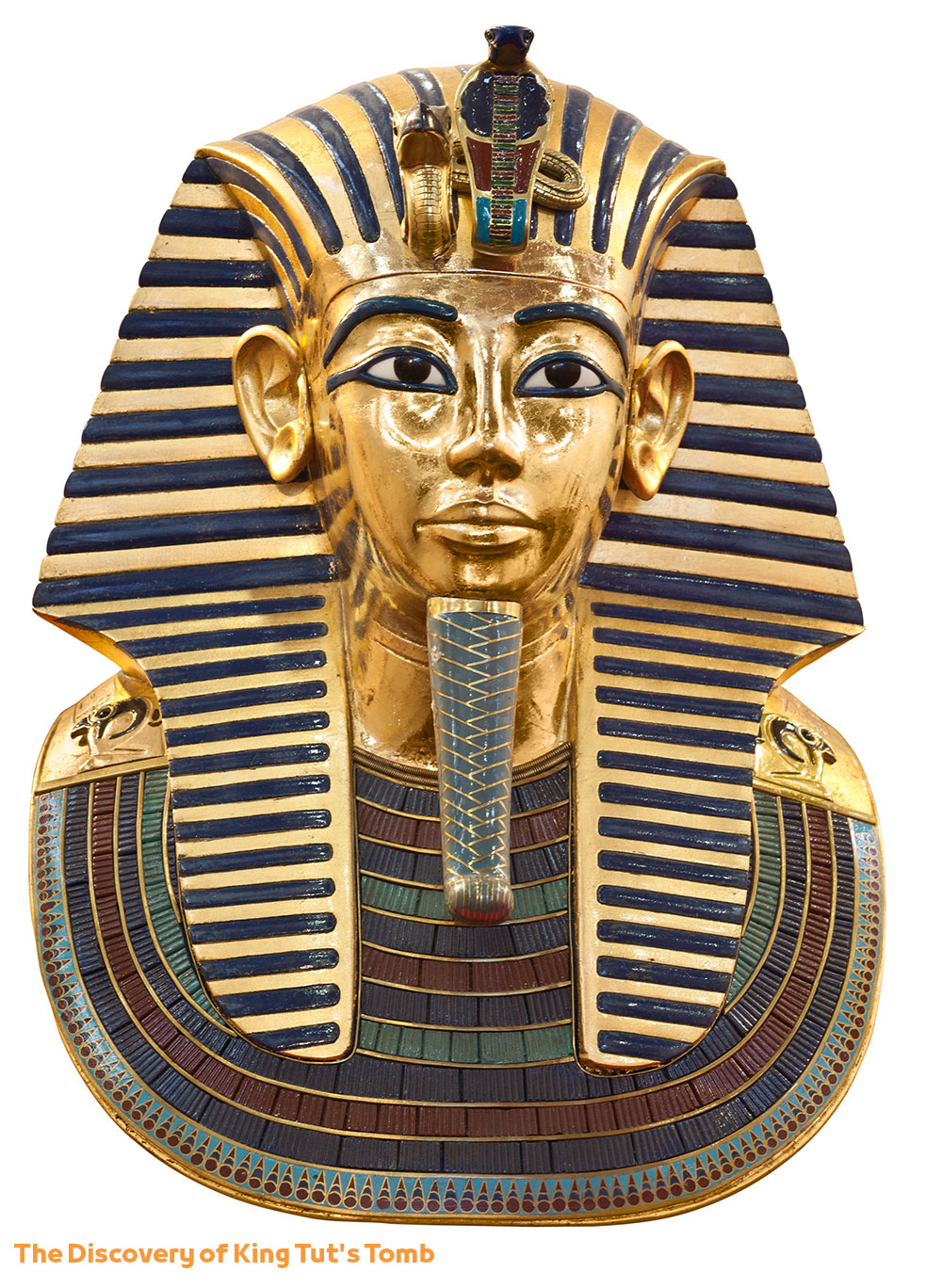
Howard Carter and the Discovery of Tutankhamun’s Tomb
His most famous phrase was when he said to Lord Carnavon: “I finally found an important discovery in the Valley of the Kings, a wonderful tomb with a seal that has never been touched before. We have closed the tomb until you arrive… Congratulations.”
Who is Howard Carter?
childHoward CarterIn England on May 9, 1874 AD, he was distinguished by drawing since childhood. When he reached adulthood, he worked as a professional painter. Then he came to Egypt to draw drawings and engravings on the walls of the Pharaonic temples in Luxor and Cairo.
He worked on professionally copying the scenes, inscriptions, drawings, and hieroglyphic writings found on the walls of the Pharaonic royal tombs.
What is the reason for his work in the field of archaeological excavation?
He met by chance the English archaeologist Sir William Flinders Petrie in 1892 AD and convinced him to work with him and train him on how to excavate and search for Pharaonic tombs and excavations using advanced scientific methods to preserve the discovered antiquities without vandalizing or breaking them.
He also taught him how to register artifacts without stealing or causing any damage to the tomb to preserve them, but he was the main reason for the damage to king Tutankhamun mummy when he took off the golden mask with a sharp, hot knife.
Historical Facts:
- Before the discovery of King Tut’s tomb, there was a record of 61 tombs, including 25 royal tombs belonging to the kings of the Pharaohs of Egypt, all of them empty and stolen from treasures, mummy, funerary furniture and everything belonging to the king, as a result of their theft by tomb thieves from the residents of Western Thebes or the treasure hunters of the Pharaohs or explorers and researchers, which were Their goal is to smuggle Pharaonic artifacts out of Egypt.
- The Sheikh was one of the people Abdel Rasool Family works withHoward CarterDuring the digging, excavation, and moments of discovering the tomb and recording each of the 5,000 pieces belonging to King Tut.

The Discovery of King Tut’s Tomb:
He was appointed Chief Inspector of Antiquities of Upper Egypt (Upper and South Egypt) by the head of the Egyptian Antiquities Service, Gaston Maspero at the time, in 1899 AD, and he was responsible for the Valley of the Kings and its surrounding areas for 5 years.
Join archaeologist Diodore Davis’ team to clean and restore the royal tombs in the Valley of the Kings.
It was transferred to the northern region of Egypt with foreign missions to uncover and excavate Pharaonic antiquities in 1904 AD.
He was fired from the Egyptian Antiquities Authority after quarreling with a group of tourists during their visit to an archaeological area in northern Egypt. He was asked to apologize to the tourists, but he refused in an arrogant and condescending manner, and accordingly an official government decision was taken to permanently expel him from government employment in Egypt.
He met Carnaphron, a “rich English businessman” who was looking for someone to help him excavate and search for Egyptian antiquities in the Valley of the Kings.
I agree Howard Carter With Carnaphron to begin digging and excavating in 1917 AD for 4 seasons in the Valley of the Kings in Luxor. It is known that the duration of the season is only 3 continuous months. Unfortunately, no finds were found.Howard CarterOn any important archaeological discovery in the Valley of the Kings area.
Carnaphron traveled to his private castle in England, upset. He used to come to Egypt to treat himself with the sun’s rays every winter and relax there, especially since he loved Egypt and the Pharaonic antiquities, in addition to being exposed to a car accident when he was young, which made him less active and searching for something.andImportant as research and excavation of Pharaonic antiquities.
The English archaeologist Howard Carter By traveling to England to persuade Carnaphron to work again to discover and excavate new places in the Valley of the Kings, after attempts, they agreed to finance only one season.
Carter obtained funding and returned to Egypt in 1922 AD to begin his new season to begin excavating the hidden treasures of the Pharaohs in Mount Qurna.
He was permanently expelled from Egypt by the Egyptian government after he refused Egyptians entry to King Tut’s tomb and his arrogance and harsh behavior towards them and many foreign tourists while visiting the Valley of the Kings in Luxor.
the Opening of King Tut’s Tomb:
- Harry Carter opened the tomb with the Earl of Carnervon and his daughter on November 29, 1923 AD.
- The official announcement at an international press conference for the opening of the cemetery today, November 30, 1923 AD.
- The first article was removed from the grave on December 27, 1923 AD.
- The opening of the burial chamber on February 12, 1924 AD.
- The royal coffin was opened in the burial chamber in early April 1924 AD.
- The first outer coffin was opened on October 13, 1924 AD.
- The second coffin was opened on October 23, 1924 AD.
- The last golden coffin was opened and the mummy was discovered on October 28, 1924 AD.
- Examining and recording the remaining treasures of the cemetery on November 11, 1924 AD.
- Inspection of the internal treasury in the cemetery on October 24, 1926 AD.
- Recording the contents of the additional rooms between October 30 and December 15, 1927 AD.
- All archaeological possessions were completely transferred from the tomb of Tutankhamun on November 10, 1930 AD.
Facts about the story of Howard Carter’s discovery of Tutankhamun’s tomb:
- The entrance to the cemetery was discovered on November 4, 1922 AD.
- The main reason behind the Earl of Carnervon’s interest in excavating the tomb was his discovery of a cartouche belonging to King Tutankhamun, in addition to mummification materials and a cup bearing the king’s name in the Valley of the Kings in 1905 AD..
- King Tut’s golden war chariot was discovered in the tomb of Vizier A.
- Excavations in the cemetery were completed until 1932 AD.
- It took 50 days to move the entire contents of the tomb into a cache.
- Carter’s story begins when he found the threshold of the stairs and then the stairs. He cleaned the stones and clay until he reached the first door, and there he discovered royal seals in an oval shape with the shape of the god Anubis above 9 prisoners – the seal of the Pharaonic royal tombs.“.
- On November 23, 1923 AD, he waited for the Earl of Carnervon and his daughter, Lady Evelyn, to officially open the tomb. On November 26, he began excavating inside the tomb until he reached a wall sealed with royal seals. He broke a small hole and began to look inside, until he was able to see the golden treasures..
Museums where Tut’s treasures were displayed:
Museums of America:
55 pieces were displayed in 6 American cities in March 1977 AD, starting with the Art Museum in Los Angeles, one of the states of America. The exhibition was attended by US President Carter and his wife, in addition to a group of famous public figures in America, Canada, and around the world.
55 artifacts were sent to be displayed in the museum, such as the royal throne chair, the Pharaonic chambers, and the golden mask. He was received by the President of the United States of America at the airport, and the streets were closed until the pieces reached the museum.
The Metropolitan Museum has imitated all of king Tutankhamun Pharaonic artifacts and offered them for sale so far, as they are considered exact copies and are expensive.
There were crowded queues to enter the exhibit and see the little king’s treasures, despite the high price of the entry ticket to $30 at the time. There were stories of love, quarrels, and divorce between couples that arose among the audience as a result of the long wait, and rumors of king Tutankhamun curse spread, reaching America.
There was a massive demonstration in front of the museum by a group of black Americans, raising slogans rejecting images of newspapers and magazines calling for racism and indicating that king Tutankhamun skin was white, as this group believes that the Egyptian Pharaohs were of African descent with black skin.
Museums of England:
50 artifacts were displayed + 81 artifacts belonging to King Akhenaten and Queen Nefertiti + an artifact discovered in Tomb of King Amenhotep II in the Valley of the Kings in Luxor, one of the most important is the cow’s head made of wood.
Germany Museums:
The coffins of king Tutankhamun were displayed with a group of treasures and jewelry in the German city of Bonn in the presence of the President Muhammad Hosni Mubarak and German Chancellor Schroeder, with the presence of an Egyptian delegation of Egyptologists, headed by Dr. Zahi Hawass.
FAQ – Questions and Answers: king Tutankhamun
Who discovered king Tutankhamun tomb?
The king’s tomb was discovered in 1922 AD Corresponding to November 29, by the British archaeologist Howard Carter.
At what age did king Tutankhamun die?
Date of death: 1323 BC.
Age: 19 years old
How much is king Tutankhamun worth?
2 million dollars.
How much is king Tutankhamun death mask worth?
2 million dollars.
How much gold is in King Tutankhamun’s coffin?
108 kg.
Did King Tutankhamun have birth defects?
The king was suffering from many diseases:
Cardiovascular disease.
Suffering from kyphosis of the spine.
Injuries and deformities of the big toe.
Why wasn’t Tutankhamun tomb stolen?
There are many explanations, including:…
- The presence of hutsWorkers Tomb of Ramses VI above the entrance to the royal tomb of King Tutankhamun.
- The presence of a large group of stones accumulated at the entrance to the tomb after torrential rains occurred in the Valley of the Kings, which helped in the disappearance of the entrance to the tomb..
- The interior design of the tomb is very complex, as there is more than one consecutive entrance and he was buried in a tightly closed chamber.
- When Ramesses VI dug his tomb, the rubble extracted from his tomb covered the entrance to king Tutankhamun tomb, which was only a few meters away from it. However, in the intervening times, this entrance was accessible and was only guarded by privates’ men.With cowardice,Several attempts were made to hack it, but it was discovered, its owners were punished, and they remained isolated.
Hurghada Lovers best Tour Operator to provide daily tours to visit the Tourist attractions of Luxor by Hurghada to Luxor Day Trips and Cairo by Hurghada to Pyramids Day Trips to discover the secrets. Book online when you come to Hurghada, El Gouna, Sahl Hashish, Makadi Bay, Soma Bay.
